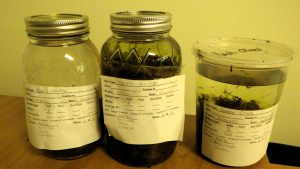Macroinvertebrates in Tryon Creek

My, June sure was a hot month this year! TCWC has been busy out in the field this summer collecting data and monitoring the watershed. It has been great to be near the water with all of the high temperatures lately. It is also important to gather data about the watershed during this unusually warm and dry summer.

A few weeks ago, volunteers Melissa and Josh helped us collect macroinvertebrates in the Tryon Creek watershed. What is a macroinvertebrate, you might ask? They are organisms that do not have a backbone and are large enough to be seen by the naked eye. Snails, worms, larvae – all of these are examples of macroinvertebrates.

Why would we care about these tiny, creepy, crawly critters? Macroinvertebrates are extremely important indicator species, meaning that examining them can reveal a great deal about the health of a stream. Different types of macroinvertebrates are more tolerant to pollution than others – some can survive in very highly polluted waters while others can only exist in the most pristine conditions. Therefore, if a stream site is only inhabited by the pollution-tolerate varieties and there are no pollution-sensitive species present, a water quality issue is very likely.
Also, macroinvertebrates are an important part of a stream’s food web. Fish and other aquatic life rely on them as their food source. If a stream does not have a plentiful and varied population of macroinvertebrates, it is likely that other wildlife will be negatively impacted.

Overall, surveying these small organisms is very important to a comprehensive understanding of stream health. It had been a few years since TCWC last sampled macroinvertebrates, so we were excited to have the opportunity to collect samples this year. The process of collecting them is quite fun and we enjoyed the experience of being up close and personal with the creek. Thank you to our volunteers Josh and Melissa for jumping right into the process and learning so quickly!

A riffle in Tryon Creek 
Placing kick net 
Looking for macroinvertebrates 
Our preserved samples


